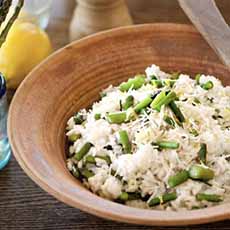TIP OF THE DAY: Cooking Rice From Scratch
|
It often surprises us to hear people who are perfectly dependable cooks say that they can’t cook rice. We’ve been cooking rice from scratch for many years, and the only time we’ve had a problem is when we didn’t check the time and the bottom rice scorched (which infuses the rest of the rice with a a scorched flavor and aroma). So if you want to take another pass at cooking perfect, fluffy white* rice, here are some tips. The process goes fairly quickly. Of course, start by reading the package directions. Wait: Start by purchasing top-quality rice. Top brands include: Instead of using a measuring cup for uncooked rice, use a scale for accuracy. Instead of placing water in a sieve or strainer† and running tap water over it, pre-wash by measuring the rice into a clean bowl. Pour cold water onto the uncooked rice, quickly stir 2 – 3 times, then discard the water immediately. This step helps to eliminate the and bran that are quickly absorbed by uncooked rice when you wash it. Use a fine mesh strainer to sieve the water out of the bowl of pre-washed rice. Make sure the unclean water is thoroughly strained out. Very gently and slowly, stir the wet, drained, uncooked rice in the strainer (do not add water). The friction between the rice grains will naturally remove any impurities that are left from the pre-wash. The gentle, slow process will prevent rice grains rice from breaking. Broken grains can cause the cooked rice to become very soggy. Now it’s time to run water through the rice. Then gently stir it a few times. |
|
|
|
Repeat the cleansing and washing processes (steps 4 and 5) three times, or until the water draining in the washing process becomes transparent. When finished, make sure all the water is thoroughly strained out. Washing is the first step toward producing perfect rice. It is more than just running water through the rice and draining. This type of washing allows the rice to absorb the water better. Impurities and debris prevent heat from distributing properly, causing unevenly cooked rice and/or overly sticky rice. Cook according to package directions. You should end up with beautiful, fluffy rice. And don’t turn your back and let the rice scorch! This happens because all the water in the pot has been absorbed by the rice before the stated end of the cooking time (maybe the heat was higher than a simmer?). Because there is no water left in the pot, the heat scorches, then burns, the rice on the bottom. ____________________ *Different types of rice have different cooking requirements. †A strainer is a type of sieve typically used to separate a solid from a liquid. The word “sift” derives from sieve. |
||





